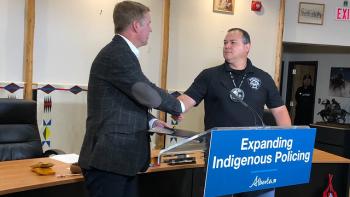Image Caption
Summary
Local Journalism Initiative Reporter
Windspeaker.com
The Siksika Nation is one step closer to the return of its own self-administered police service.
“If you don’t have basic safety and security, you’re not going to meet your full potential as a community,” said Chief Ouray Crowfoot.
The First Nation is in talks with the Alberta and federal governments to establish an operational timeline for the transition of services from the RCMP to the Siksika Nation police service.
To that end, said Public Safety Canada Minister Marco Mendicino in a statement, Canada and Alberta are supporting two full-time employees to advance the work.
This is the next step that began with 2018 feasibility study funded through a $30,000 provincial grant provided to Siksika. That feasibility study led to a memorandum of understanding signed with Alberta and focused on developing a funding framework for the new police services.
Indigenous police services have been funded through the First Nations and Inuit Policing Program (FNIPP), with the federal government providing 52 per cent of the cost and the province paying the remaining 48 per cent.
How the Siksika police force will be funded will be “determined as part of a separate process,” said Louise McEachern, spokesperson for Alberta Justice, in an email to Windspeaker.com.
For the past two years, Ottawa has frozen funding to FNIPP.
The transition to the self-administered police service for the Siksika Nation is the first in Canada in 14 years.
The transition will include “designing a process that will ensure the handover from the RCMP to the new police service takes place without any interruptions in vital services to local residents,” said McEachern.
Twenty years ago, says Crowfoot, the Siksika police force was dependant on federal transfer agreements. However, a recent land claim settlement of $1.3 billion with the federal government allows Siksika to have its own resources to supplement costs.
“It’s just crazy that a force can just be taken away… It’s unheard of in anywhere but a First Nation,” said Crowfoot.
The Siksika police force operated from 1992 to 2002 under a 10-year agreement with the federal and provincial governments.
Crowfoot points to the inequity in policing services right now. Gleichen, a nearby hamlet of 200 residents, has an RCMP detachment, while Siksika, with a population of 4,500 on reserve and 8,000 members, does not.
The vast majority of the calls the Gleichen detachment fields, around 85 per cent, come from Siksika.
“Even if we had the best relationship with the RCMP, it’s still not the same as having our own (police),” said Crowfoot.
“When you don’t have a force on the nation that knows the nation, that knows the roads and knows the community, when we’re talking about response time, those critical minutes, those critical seconds can make the difference between going to the hospital, going to the police or going to the morgue.”
When Siksika’s police force is up and running, it will join two other Blackfoot Nations in the south that operate their own police forces, the Blood Tribe and the Tsuut’ina Nation.
This year marks 31 years of operation for the Blood Tribe Police Service, which is also the oldest First Nations police service in Canada.
The Tsuut'ina Nation Police Service has been operating since 2004.
In Alberta’s north, the Lakeshore Regional Police Service has been operating for 14 years and serves the five northern First Nations of Sawridge, Swan River, Driftpile, Sucker Creek and Kapaweno.
Currently Alberta funds the three First Nations police services annually at $6.4 million, as well as spending more than $500,000 every year to pay for a crime prevention coordinator for each service.
This past June, the province topped up that funding to allow for each police service to hire five new members over the next four years. The move was to address the federal government’s decision to freeze funding to FNIPP.
The three First Nations police services currently have a combined 62 members.
Local Journalism Initiative Reporters are supported by a financial contribution made by the Government of Canada.

